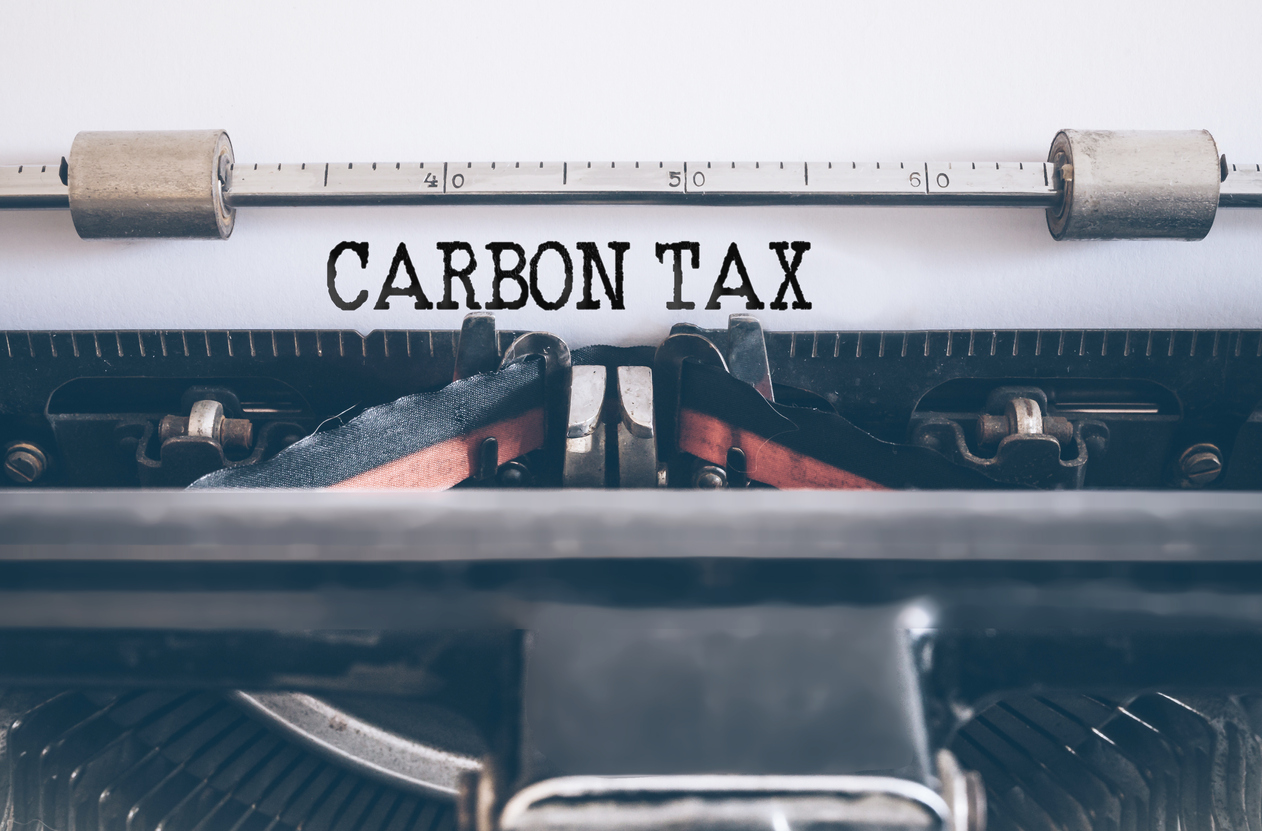
Carbon Tax – An Indian Perspective
Encouraging tax on usage of fossil fuels to mitigate climate change and address cross border tariffs
Over the past few decades, climate change has emerged as a global challenge that calls for an integrated international response. India is a party to the United Nations Framework Convention on Climate Change (UNFCCC) that aims to reduce greenhouse gas (GHG) concentration in the atmosphere. India has also ratified the Paris Agreement, a legally binding international treaty on climate change. Amongst other goals, the Paris Agreement seeks to achieve carbon neutrality from the year 2050 onwards. By ratifying the Paris Agreement, India pledged to follow the low carbon path to progress, on the assumption of unencumbered availability of cleaner sources of energy, technology and financial resources from around the world. In this regard, Prime Minister Narendra Modi recently said that the country is on track to achieving its climate goals well before the target date as it is continuing to switch over to energy-efficient mediums and using waste to generate energy.
Considering its international commitments, India has taken various regulatory and fiscal measures over the past few decades to address climate change. Its National Action Plan on Climate Change (NAPCC) enshrines eight national missions such as National Mission for Enhanced Energy Efficiency, Green India mission etc that provide the framework for adopting multipronged and integrated strategies to mitigate climate change. However, despite these efforts, India is constantly ranked as one of the largest emitters of carbon dioxide (CO2) after China and the United States.
CO2, a primary GHG, is one of the main contributors to climate change and is mainly emitted through the burning of fossil fuels, especially coal. In India, 68.7% percent of GHG emissions come from the energy sector, followed by agriculture, industrial processes, transportation, livestock management and waste.
In 2010, the Government introduced a Clean Energy Cess on coal with the dual intention of:
- earmarking part of the revenue to fund research and innovative projects in clean energy; and
- indirectly drive up the consumption of cleaner fuel by increasing consumption cost of coal.
However, with the rollout of the Central Goods and Service Tax Act, 2017 (GST), the Clean Energy Cess along with twelve others cesses were abolished and subsumed by a new cess called the Compensation Cess. Under the new regime, coal was subject to tax at the same rate of INR 400 per tonne. Notably, while Clean Energy Cess was only levied at the time of production or import of coal, Compensation Cess is levied at every point of supply.
Though, regardless of the form of levying a cess, the Government failed to achieve the desired results as only a miniscule portion of revenue was directed towards research. Further, cleaner sources of energy such as large-scale solar grids had parity costs with coal and hence the demand for such clean energy sources did not increase. Additionally, while levying a cess penalises the usage of coal, it is not linked to the quantum of carbon emissions emitted by a taxpayer. Hence, a taxpayer would be subject to the same rate of tax regardless of whether he opts for a cheap polluting variety of coal or a comparatively expensive low carbon emitting coal, colloquially referred to as clean coal.
Apart from federal measures, certain Indian states have also taken steps to reduce GHG emissions. For instance, since 2013, the Goa Government has been levying a ‘Green Cess’ on products and substances causing pollution. Similarly, the Uttarakhand Government had decided to introduce an ‘Eco Tax’ on vehicles entering the hill station of Mussoorie.
However, none of these measures have been efficient in reducing carbon emissions and consequently mitigating climate change. Therefore, it may be worthwhile to consider adopting new fiscal measures such as a ‘carbon tax’ to reduce GHG emission. Broadly, carbon tax refers to levying a charge on GHG emitters with the intention of discouraging the use of all types of fossil fuel and not just coal. Further, it is generally linked to GHG emissions unlike the current model of cess in India which is linked to consumption of coal.
Global Front-Runners in the Race Against Climate Change by Adopting a Carbon Tax
Finland first adopted a carbon tax in 1990, followed by Norway, Sweden and Denmark. Since then, various developed and developing nations have adopted a carbon tax such as the United Kingdom, France, Canada etc. Just last month, the Indonesian Ministry of Finance has also announced plans to introduce carbon tax. Further, the European Union (EU) is in the process of implementing a ‘Carbon Border Adjusted Mechanism’ (CBAM), which proposes that carbon emitting goods (such as cement, steel, aluminum, glass etc.) entering the EU would be taxed at the borders. The CBAM was proposed because companies in the EU are legally required to purchase permits to undertake manufacturing processes wherein GHG are emitted. This extra cost raises the price of the finished products manufactured within the EU thereby making importing cheaper from countries where such economic measures are not imposed. Hence, imposing tariffs on imported goods would increase their price due to the additional tax cost resulting in making them less attractive for buyers and could shrink demand. Therefore, CBAM seeks to adjust the price difference between goods manufactured within the EU and goods manufactured in other jurisdictions. Notably, a similar proposal is also being considered by the United States of America.
As India’s third largest trading partner, the EU accounted for USD 74.5 billion worth of trade in goods in 2020. Till now, Indian goods had a competitive advantage in the EU as they were comparatively cheaper than the goods manufactured by EU companies. However, with the introduction of CBAM, for an EU based consumer importing goods from India will likely cost as much as procuring goods manufactured within EU. Hence, demand for Indian-made good will likely decrease and consequently affect India’s export industry. While India along with other nations have vehemently opposed the CBAM terming it as discriminatory, the EU has dismissed these claims. According to European Commission vice-president Frans Timmermans “if other countries moved to tax carbon on exports, then “the reason for a carbon levy on imports disappears. If they don’t, we would have no hesitation whatsoever in moving forward with the plan”.
Therefore, in addition to a strong environmental argument to introduce carbon tax, India must also factor in the possibility that if multiple countries adopt cross border carbon tariffs in the future, then the global demand for Indian goods may shrink resulting in a huge setback for export-oriented businesses. However, this situation can be mitigated where going forward Indian manufacturing industry is compelled to manufacture goods in a sustainable manner as such goods would not be responsible for carbon emissions and hence possibly be exempt from penalty in the form of cross border tariffs.
Introducing Carbon Tax in India
As set out above, India has undertaken various fiscal measures to reduce its carbon footprint such as charging a cess on coal, levying an excise duty on petroleum products etc. However, given that none of these measures have been successful, India should consider introducing a comprehensive carbon tax as it will help to serve a three-fold purpose:
- disincentivise the use of carbon emission intensive inputs and outputs;
- the revenue collected can be utilised to promote research of cleaner alternatives and to support renewable energy projects. Developing sustainable alternatives will help Indian products match international standards and consequently be exempt from cross border tariffs; and
- create uniformity between federal and state measures to ensure streamlined implementation.
Implementation
When the GST reform was being worked out, a major change proposed to the mode of taxation was to shift the accrual of taxes from the state where goods and services were being manufactured to the state where they were being consumed. Hence, manufacturing states feared that their tax revenues would reduce. To achieve a consensus and bring states on board, the Centre agreed to find a way to make good any loss in state revenue owing to the implementation of GST. In light of this commitment, Compensation Cess was introduced in 2017, for a period of five years.
Hence, even though Compensation Cess effectively replaced Clean Energy Cess, unlike Clean Energy Cess, the revenue collected the form of Compensation Cess is meant to be distributed to state governments and is not earmarked for an environmental cause. Further, since Compensation Cess has not yet been extended beyond 2022, revamping Compensation Cess is not ideal.
Accordingly, going forward, whenever the Indian government decides to adopt a carbon tax, it may consider abolishing the existing Compensation Cess limited to its levy on coal and instead introduce carbon tax in form of a revised Clean Energy Cess.
Though, unlike the previous model of Clean Energy Cess, which applied only to coal, the proposed cess should cover all forms of fuels such as petrol, crude oil, natural gas etc. Hence, it should have a broader scope. Further, the proposed Clean Energy Cess must be linked to the quantum of carbon emissions and not the procurement of fuel itself. Hence, the rate of cess may vary based on the capacity of a product to emit GHG. This would help to incentivise usage of comparatively cleaner alternatives. However, the government must ensure that the proposed cess is levied only at one leg of the transaction to avoid double taxation. Additionally, the revenue collected should be accounted for on a regular basis.
Needless to say, the proposed Clean Energy Cess should only be introduced in a realistic and gradual manner to ensure that the stakeholders have enough time to prepare for it especially given the economic situation as a result of the pandemic. Further, certain thresholds may be prescribed to ensure that small business are not hampered.
Conclusion
Tax law has been used time and again to steer taxpayer behavior. Adopting a carbon tax will not only help India fulfill its pledge of reducing carbon emission but with increasing emphasis on cleaner products across jurisdictions, Indian businesses can continue to remain attractive.
All views are personal.



